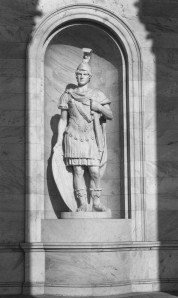The God Mars and Florence June 24, 2010
Author: Beach Combing | in : Medieval , trackback
Beachcombing has a special place in his heart for Florence and today, in celebration of the Arno’s flower, on the day of St John no less, he sets out a Florentine mystery: the fate and idenity of Mars on Horseback.
We hear of this particular statue in the work of Florence’s first medieval chronicler, the great Giovanni Villani. Villani tells us that in his own lifetime (1280-1348) there had stood at the Ponte Vecchio (the Old Bridge) a statue to Mars. It was at the foot of this statue, according to Villani (5, 39), that Bondelmonte, a rich Florentine, was dragged from his horse and had ‘his veins opened’ by his enemies. It was also a statue that was held in great esteem by the population. So, in 1300, the statue was moved as the bridge was being rennovated (8,39) ‘and whereas at the first it looked towards the east, it was turned towards the north, wherefore, because of the augury of old, folk said: ‘May it please God that there come not great changes from this to our city’.
It is remarkable that a Christian city should pay such attention to an object from pagan antiquity. Beachcombing can think of no other cases of medievalies (let alone medieval commoners) venerating a classical object in this manner prior to the high Renaissance. At most we have some displaced pride in a local set of Roman ruins, but here was a statue that had become a rabbit’s foot for all of Firenze.
What did this statue look like? We do not know because it was washed into the Arno in the flood of 1333 – it doubtless rests there to this day with other treasures stolen over the years by the angry river. But Villani, who had clearly seen it, comes at the question obliquely while describing the ancient temple of Mars in Florence: that he associated (wrongly) with the Baptistery of St John (1.42). ‘Very noble and beautiful [the pagan Romans] built [the temple/baptistery] with eight sides, and when it had been built with great diligence, they dedicated it to the god Mars, who was the god of the Romans, and they had his effigy carved in marble in the likeness of an armed cavalier on horseback. They placed him on a marble pillar in the midst of that temple, and held him in great reverence, and adored him as their god so long as paganism continued in Florence.’
‘[H]is effigy carved in marble in the likeness of an armed cavalier on horseback’? Beachcombing skipped Roman art class… But an equestrian Mars? It doesn’t sound very likely. Far more probable is that an equestrian statue – or whatever survived by this date of an equestrian statue – had been associated with Mars because of the conviction of medieval Florentines that their city was warlike – at best a half truth.
But what was this cherished statue really? Robert Davidsohn one of Florence’s most celebrated modern historians – a Gdansk Jew who died in 1937 just before the Fascist racial laws could ruin his twilight years – claims that the statue was an effigy of a Dark Age barbarian leader, Theodoric. But a statue in marble from the early Middle Ages is unheard of. It seems far more likely that it would have been one of the Roman Emperors who enjoyed an unlikely semi-immortality on the banks of the Arno. Or was the statue incomplete and was the ‘missing’ horse just an erroneous medieval guess? Beachcombing would be grateful for any suggestions [drbeachcombing[AT]yahoo[DOT]com].
Someday, downstream from Florence, a lucky swimmer or boatsman may be able to give a definitive answer to these questions.



